Legs and feet come in all shapes and sizes. Some people have thin calves and wide feet. Some have wide calves and slender feet. Your leg size is as unique as you are.
And if you’re looking for a solid pair of compression socks, you need a pair that fits you perfectly. These health-boosting compression socks can come with a variety of features designed to meet the needs of different wearers.
Additionally, if you’re someone with wide-calves, finding a pair of compression socks that is not uncomfortable is important in making them work for you.
That’s why we recommend ComproGear’s XL, XXL, or XXXL socks for your specific needs!
Before we jump into why ComproGear Extra Wide Calf Compression Socks are best for wide calves, let’s look into what compression socks actually do and the importance of getting just the right fit for you.
What Are Compression Socks?

Compression socks are a pair of elastic garments that are specially designed for compression therapy of your legs.
They apply light pressure to your legs to promote blood flow and relieve you of calf, leg, and foot pain.
They also help reduce swelling in your ankles and lessen many venous disorders.
People who have to stand a lot during their jobs, such as nurses and flight attendants, often wear compression socks. But it’s not limited to that.
Even runners and athletes wear them often. If you are suffering from general leg pain, putting on a pair of compression socks can be very beneficial.
Getting The Right Pair of Compression Socks
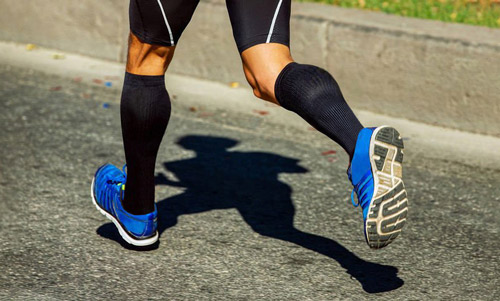
With such versatility, compression socks are sold in a variety of sizes, pressure levels and purposes. Size is extremely important when it comes to compression socks.
Wearing socks that don’t fit just right may prevent you from getting the full therapeutic benefits of compression socks. Instead of alleviating leg and foot pain like they’re designed to do, they will only increase the discomfort.
Not only are ill-fitting socks uncomfortable, they also may cause problems like skin redness, skin damage and poor blood circulation. In particularly severe cases, socks that don’t fit right can cause blood clots.
Getting the right size of compression socks is also easy to do, as they are sold in a variety of options.
How to Measure Your Legs for Knee High Compression Socks
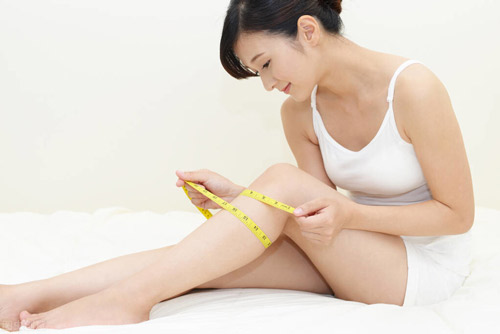
When looking for the perfect pair of compression socks for you, you need to have the right measurements of your legs. With an accurate size of your legs and feet, you can find the size that will perfectly fit you.
In order to properly measure your legs for the right-sized compression socks, follow these easy steps:
- Measure the circumference of your leg around the ankle, just above your ankle bone.
- Measure the circumference of the widest part of your calf.
- Measure the length of your lower leg from the floor to the bend behind your knee.
Taking these measurements is an important step in getting a pair of compression socks that will work for you. Before taking measurements, keep these things in mind:
- Take measurements when you get up from bed in the morning. This helps prevent inaccurate measurements due to any swelling that occurs throughout the day. (In case you were wondering “Can you Wear Compression Socks to Bed?” the answer is No.)
- Take measurements while you are standing straight on the ground.
- Make snug measurements around your skin.
- Avoid measuring over socks or slacks.
Find the Right Fit
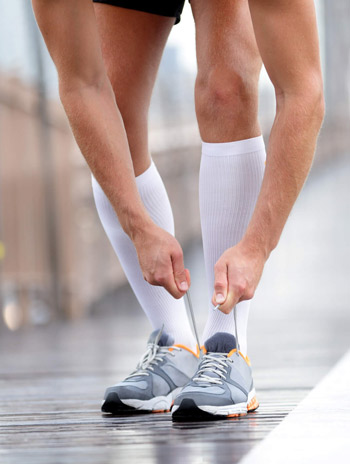
After getting the correct measurements of your legs, the next step is to choose the right compression socks for your limbs.
Just like a shoe company provides a size chart for different feet lengths, you can also find size charts for compression socks.
Compression socks should fit snugly around your lower legs and feet. However, they should not be too tight that they restrict your movement.
The sock fabric should be breathable and your skin should not sweat underneath it. Above all, they should be comfortable, so go for the pair you find yourself most comfortable in.
Size Chart for Compression Socks

Compression sock companies provide you with charts containing socks’ sizes for different lengths and widths of legs.
If you are ordering compression socks online, be sure to follow the size chart and find the optimum sized socks before placing an order.
Use the measurements you made of your legs to choose the right sock for you. The calf circumference, which is the girth of the widest part of your calf, is the most important measurement.
If you don’t want to measure your calf and ankle circumference, your shoe size might also do the trick. Still, we strongly recommend that you take proper measurements to maximize the socks’ benefits.
Problems with Wearing Wrong Sized Compression Socks
Wearing compression socks that aren’t the right size or wearing the correct size improperly may result in some serious problems. These issues include things like:
- Skin irritation
- Broken skin
- Temporary dents in the skin
- Discomfort
- Itching
- Increase in swelling
- Poor blood circulation
- Blood clots in severe cases
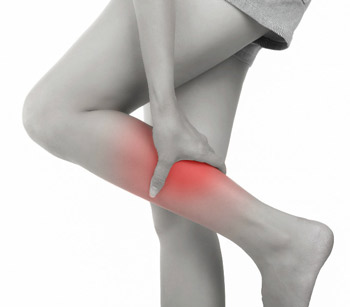
Prevent these ailments by finding a pair of socks in the right size and wearing them the right way.
Making compression socks work for you
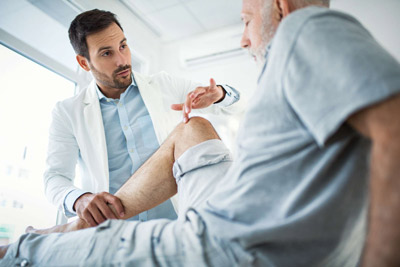
If compression socks are not working for you, don’t hesitate to consult a doctor.
The amount of compression your legs need might change with time and a doctor can prescribe what’s best for you. Feeling tingling and numbness in your legs can be a sign that you are wearing compression socks of the wrong size.
In addition, with the increase in age, there is a significant decrease in physical activity. This can lead to an increase in weight, which can cause stress to your venous system.
Pain and swelling in the feet are usually the first symptoms of venous insufficiency. The blood flow in the legs is disturbed due to the skin becoming dry, thin, and more exposed to infection.
To cope with such problems, see a doctor to choose a pair of compression socks that will work best for you.
If you have larger calves, you may want to look for a a pair that’s specifically designed for large calves. Usually, these socks will be extra wide in the top part of the sock. This size difference helps the sock fit better for your unique needs.
ComproGear Graduated Compression Socks: The Best Compression Socks for Large Calves
ComproGear compression socks provide the best compression therapy for your wide calves with their extra-wide compression socks.
They are feasible for nurses, athletes, diabetics, pregnant women, and many others.
ComproGear’s knee-high compression socks are made with remarkable anti-embolism technology that enables your blood to circulate easily through your veins. This helps in freeing your lower legs and ankles from any kind of pain.
The top elastic binding is made up of a soft material that gently wraps around your skin without digging into your skin too much. This provides you with an extra level of comfort.
Wearers of these socks find them to be super breathable and say that they keep sweat from accumulating on your skin.
These socks are available in four sizes and up to an extra-large size that easily fits wide calves with a circumference of 20 inches. The 35 percent spandex in these socks is the highest spandex content of all the compression socks available in the market.
This high spandex content in the fabric provides optimum and uniform pressure to your legs, making ComproGear the world leader in the compression sock market.
Why are ComproGear compression socks a world-leading brand for compression socks?

- ComproGear compression socks are ideal for all kinds of activities including hiking, biking, jogging, or regular workouts.
- They are designed for nurses, teachers, pregnant women, flight attendants, athletes, and anyone who wants to relieve leg pain.
- ComproGear socks are ideal for coping with varicose veins, deep vein thrombosis, skin ulcers, swelling, and discomfort in general.
- They effectively fight against fasciitis pain.
- They are available in multiple sizes, so finding the perfect fit is extremely easy.
- Durability is 100% guaranteed; you won’t have to get a replacement just after 9 to 10 washes.
Specifications
- Material: 65% Nylon and 35% Spandex.
- Compression: 20-30 mmHg.
- Size: Small, Medium, Large, X-Large.
- Color: Black, Blue, Red, Yellow Stripes, and Blue/Brown Chevrons.
Check out these related articles to learn more about compression socks.
Popular Articles on ComproGear
- Sock Soothers
- Compression Sleeves for Legs
- Medical Compression Socks
- Compression Socks for Men
- Best Compression Socks for Swelling
- Wide Calf Compression Socks
- Can You Wear Compression Stockings 24 Hours a Day
- Toeless Compression Socks
- Easy To Put On Compression Socks for Elderly
- Do Compression Socks Help Gout
Tips to Put on Compression Socks
Once you find the perfect pair of compression socks for your legs, it’s time to put them on.
Even if you find the perfect fit for your calves, putting on compression socks can be a bit of a challenge. It has to be done with the right technique and approach. Otherwise, the socks can cause a great deal of annoyance. In order to easily slide the socks up your legs, keep these simple tips in mind.
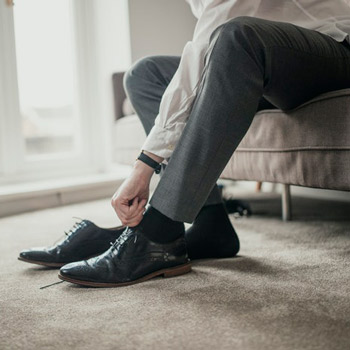
Put them on in the morning
Put your socks on right away in the morning. If your legs are swollen, sliding on a pair of tight compression socks can be a cause of intense pain.
Putting on compression socks should be one of the first things you do in the morning, as swelling is at a minimum at this time.
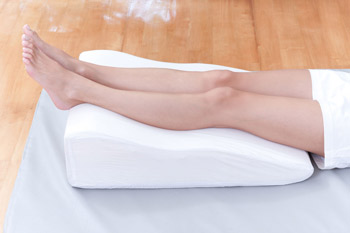
Reduce swelling
If you’re looking for a way to reduce swelling to help you get your socks on easier, we’ve got a tip for you.
Lay on a bed and raise you legs above your body. Stay in this position for a few minutes. This should lessen swelling and make it easier to put your socks on. We also recommend the best dha you can afford to increase Omega-3 concentration in the body.
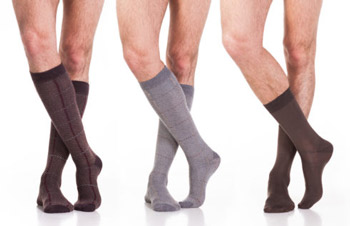
Align the socks properly
Before sliding your socks on, make sure that the socks are properly aligned. Compression socks provide varying pressure at different lengths of the socks, with the tightest part being in the ankle area.
If you put on the socks with a wrong alignment, your compression therapy might be affected.

The right method
Once you have aligned the sock properly with your feet, fold its top part outwards. Now, slide your foot into the opening and unfold the sock over your ankle. Make sure that you leave no wrinkles or bunches behind. This can reduce comfort as well as effectiveness.
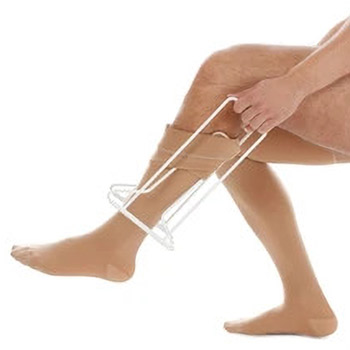
Use a donning aid
Several tools and devices are available that help with putting on compression socks. One such device is called the stocking donner. This makes it easy to slide your feet inside the socks.
If you suffer from back pain or have any sort of mobility issues, a donning aid could be your best option to get your socks on easier.

An extra pair of hands won’t hurt
If you have bending or mobility issues, putting on compression socks can be a bit harder. If you can’t do it on your own, ask a friend or a loved one for help.

Taking off the socks
While removing the compression socks off your feet, never roll them down your legs. This can make the socks act like a tourniquet and hinder the flow of blood.
To take your socks off, smoothly slide them off your legs. To make your grip firm, you can use rubber gloves. Several tools also exist to aid you.
Take Good Care of Your Socks
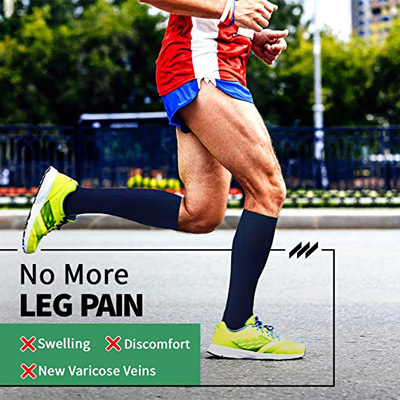
While ComproGear compression socks are made of high-quality material and are quite durable compared to other brands, we recommend you take good care of your socks.
These socks stand beside you in hours of pain and absorb most of it. They do deserve some respect.
For the best output, we recommend machine washing them in cold water. Also, avoid using the internal dryer of the washing machine. Use an air dryer instead.
